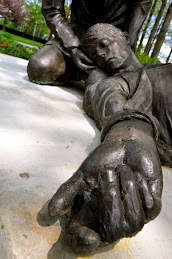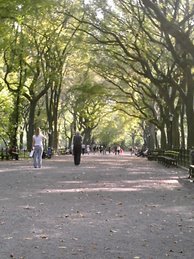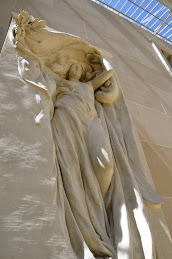By Joseph Kellard
I want to pass along four outstanding opinion pieces that I read this week. I’ve provided a brief description of each piece, along with their links and an excerpt from each one.
Keith Lockitch of the Ayn Rand Institute tackles and challenges the growing push for “environmentally-friendly” energies in his op-ed “The Green Energy Fantasy.”
“There is a reason why less than 2 percent of the world’s energy currently comes from ‘renewable’ sources such as wind and solar--the very sources that are supposedly going to power the new green economy: despite billions of dollars in government subsidies, funding decades of research, they have not proven themselves to be practical sources of energy. Indeed, without government mandates forcing their adoption in most Western countries, their high cost would make them even less prevalent.”
Gina Gorlin challenges those who laud Obama as an intellectual to take a second look at this belief in her piece “Obama the Intellectual?,” published in the latest edition of the Objectivist student newspaper The Undercurrent.
“In action, Obama is clearly not an intellectual. He, like Bush and other politicians, is a pragmatist—the exact opposite of an intellectual. Issue after issue, including taxes, the Iraq war, and the environment, reveals that Obama has made decisions, not with reference to firm principles derived from a careful and scholarly investigation of the facts, but by trying to find some middle ground in a landscape of competing opinions.”
Over at Real Clear Politics, Robert Tracinski takes on the task of deciding whether President Obama will turn out to be more like FDR or Jimmy Carter in his column “The ‘Can-Do’ Economy Killer.”
“I have been wondering whether Barack Obama will turn out to be another Jimmy Carter or another Franklin Roosevelt. The least bad option is Carter: a leader whose policies are disastrous for the economy and for US foreign policy, but who ends up being rejected by the American people and voted out of office after only one term -- as opposed to a leader like FDR, whose policies are also disastrous, but who ends up being loved by the American people nonetheless and voted back into office.”
Elsewhere, Tracinski writes about the influence Ayn Rand’ ideas are having on some in the media who are challenging and speaking out against Obama’s “stimulus” plan, and others calling for greater government intervention in the economy, in his column “The Ayn Rand Factor in the Santelli Revolt.”
“It is no coincidence that the strongest resistance to a government takeover of the economy is coming from people influenced by Ayn Rand. She has long functioned as a stiffener of resolve and as the fountainhead of pro-free-market ideas.”
Saturday, February 28, 2009
Sunday, February 22, 2009
New York Times Prints Letter on Stimulus-Stagflation
By Joseph Kellard
The New York Times today revised and printed a letter I submitted to the newspaper in reply to an op-ed by Paul D. Ryan, which I posted about here on Feb. 17 ("Not a 'Stimulus' But a Return to Stagflation"). Recall that Ryan's editorial, entitled "Thirty Yeas Later, a Return to Stagflation," concluded that the "stimulus" plan will only ultimately lead to higher inflation and higher unemployment.
Below is my letter as printed.
To the Editor:
Paul D. Ryan properly points to the lesson of the government-induced stagflation of the 1970s as the result of the same spending and borrowing policies of the "stimulus" plan. He also recognizes that the Federal Reserve's policies of manipulating interest rates and expanding the money supply were an essential cause of today's financial crisis.
But instead of calling for reforms and cost controls for Social Security, Medicare and Medicaid, Mr. Ryan should propose drastic cuts in spending on these entitlements.
Government interference in the economy fundamentally caused today's crisis, and only more freedom -- more separation between state and economics -- will get us out of it.
Joseph Kellard
East Meadow, N.Y., Feb. 14, 2009
The New York Times today revised and printed a letter I submitted to the newspaper in reply to an op-ed by Paul D. Ryan, which I posted about here on Feb. 17 ("Not a 'Stimulus' But a Return to Stagflation"). Recall that Ryan's editorial, entitled "Thirty Yeas Later, a Return to Stagflation," concluded that the "stimulus" plan will only ultimately lead to higher inflation and higher unemployment.
Below is my letter as printed.
To the Editor:
Paul D. Ryan properly points to the lesson of the government-induced stagflation of the 1970s as the result of the same spending and borrowing policies of the "stimulus" plan. He also recognizes that the Federal Reserve's policies of manipulating interest rates and expanding the money supply were an essential cause of today's financial crisis.
But instead of calling for reforms and cost controls for Social Security, Medicare and Medicaid, Mr. Ryan should propose drastic cuts in spending on these entitlements.
Government interference in the economy fundamentally caused today's crisis, and only more freedom -- more separation between state and economics -- will get us out of it.
Joseph Kellard
East Meadow, N.Y., Feb. 14, 2009
Saturday, February 14, 2009
Not a "Stimulus," But a Return to Stagflation
By Joseph Kellard
The New York Times today (Sat., Feb. 14) has a good op-ed by Paul D. Ryan entitled “Thirty Years Later, a Return to Stagflation.” In it, Ryan, who is described as a Republican representative from Wisconsin, concludes that the “stimulus” plan will only ultimately lead to higher inflation and higher unemployment.
Here’s the beef of Ryan’s op-ed:
“Combine high inflation and high unemployment and you have stagflation. Hindsight shows how the pain of the late 1970s and early 1980s could have been avoided, yet we’re now again planning to borrow and spend — and raise taxes — as President Jimmy Carter did. Soon we may again find ourselves watching a rising ‘misery index’ of inflation and unemployment together. If that happens, individual earning power will evaporate, and our standard of living will decline.
“To prevent stagflation, we should enact fiscal policy reforms that apply the lessons we learned from the 1970s. Keynesian stimuli based on borrowing and spending have not worked and will not work. One-time rebate checks do not increase the incentive to expand business operations and create jobs. But marginal cuts in tax rates do. We also must lower our job-killing corporate income tax rate, the highest in the industrialized world after Japan, and ease business worries by making it clear that there will be no tax increases in 2010.
“We should also re-establish the sound dollar. For the past decade, the Federal Reserve has manipulated interest rates and vastly over-expanded the money supply — and in so doing fueled the housing bubble that precipitated our current crisis …”
Unfortunately, Ryan doesn’t call for drastic cuts in spending to accompany his proposed tax cuts, and he calls for “reform” for those socialist behemoths otherwise known as Social Security, Medicare and Medicaid. Nevertheless, this is a good op-ed that should be given support with positive letters to the editor: letters@nytimes.com.
Here’s my letter:
To the Editor:
Paul Ryan is correct, the “stimulus” plan will only ultimately lead to higher inflation and higher unemployment “Thirty Years Later, a Return to Stagflation” (Sat., Feb. 14).
Ryan properly points to the lesson of the government-induced stagflation of the 1970s as the logical result of the same state spending and borrowing policies at the core of the current plan. He also recognizes that the Federal Reserves policies of manipulating interest rates and expanding the money supply were an essential cause of today’s financial crisis. However, instead of calling for reform of Social Security, Medicare and Medicaid, Ryan should be targeting these bureaucratic behemoths for drastic spending cuts to accompany his proposed tax cuts.
Government interference in the economy fundamentally caused today’s crisis, and only more freedom -- more separation between state and economics -- will get us out of it.
Joseph Kellard
East Meadow, NY
Joseph Kellard is a journalist and commentator living in New York. Contact him at Theainet1@optonline.net.
The New York Times today (Sat., Feb. 14) has a good op-ed by Paul D. Ryan entitled “Thirty Years Later, a Return to Stagflation.” In it, Ryan, who is described as a Republican representative from Wisconsin, concludes that the “stimulus” plan will only ultimately lead to higher inflation and higher unemployment.
Here’s the beef of Ryan’s op-ed:
“Combine high inflation and high unemployment and you have stagflation. Hindsight shows how the pain of the late 1970s and early 1980s could have been avoided, yet we’re now again planning to borrow and spend — and raise taxes — as President Jimmy Carter did. Soon we may again find ourselves watching a rising ‘misery index’ of inflation and unemployment together. If that happens, individual earning power will evaporate, and our standard of living will decline.
“To prevent stagflation, we should enact fiscal policy reforms that apply the lessons we learned from the 1970s. Keynesian stimuli based on borrowing and spending have not worked and will not work. One-time rebate checks do not increase the incentive to expand business operations and create jobs. But marginal cuts in tax rates do. We also must lower our job-killing corporate income tax rate, the highest in the industrialized world after Japan, and ease business worries by making it clear that there will be no tax increases in 2010.
“We should also re-establish the sound dollar. For the past decade, the Federal Reserve has manipulated interest rates and vastly over-expanded the money supply — and in so doing fueled the housing bubble that precipitated our current crisis …”
Unfortunately, Ryan doesn’t call for drastic cuts in spending to accompany his proposed tax cuts, and he calls for “reform” for those socialist behemoths otherwise known as Social Security, Medicare and Medicaid. Nevertheless, this is a good op-ed that should be given support with positive letters to the editor: letters@nytimes.com.
Here’s my letter:
To the Editor:
Paul Ryan is correct, the “stimulus” plan will only ultimately lead to higher inflation and higher unemployment “Thirty Years Later, a Return to Stagflation” (Sat., Feb. 14).
Ryan properly points to the lesson of the government-induced stagflation of the 1970s as the logical result of the same state spending and borrowing policies at the core of the current plan. He also recognizes that the Federal Reserves policies of manipulating interest rates and expanding the money supply were an essential cause of today’s financial crisis. However, instead of calling for reform of Social Security, Medicare and Medicaid, Ryan should be targeting these bureaucratic behemoths for drastic spending cuts to accompany his proposed tax cuts.
Government interference in the economy fundamentally caused today’s crisis, and only more freedom -- more separation between state and economics -- will get us out of it.
Joseph Kellard
East Meadow, NY
Joseph Kellard is a journalist and commentator living in New York. Contact him at Theainet1@optonline.net.
Sunday, February 8, 2009
Art and The Inconsequentialness of Nature
By Joseph Kellard
On Saturday I was enticed to the Nassau County Museum of Art for the exhibit: “Poetic Journey: Hudson River Paintings from the Grey Collection.” (The next day, the New York Times gave it a well-deserved positive review: "For Serene Transport, Hudson River School Paintings.")
I enjoy some paintings from this school, particularly those of Albert Bierstadt, for their panoramic landscapes of valleys and mountains and their stylized recreation of nature, especially their brilliant colors and sharp contrasts between light and dark (e.g. http://tinyurl.com/dy3y5t). When men appear in these paintings, I view them mainly as a means for the artist to accentuate the vast landscapes and to lend them some perspective.
Unfortunately, my positive experience at the exhibit was undercut, slightly, by some of the descriptions of the paintings (which, I was told, are usually written by the curator):
“Trout Stream” by T. Worthington Whittredge, 1870s
“… The man fishing in the background is symbolic of the smallness of humanity compared to the grandeur of nature. The fisherman seems so inconsequential next to the enormous trees and beautiful, glittering steam that he almost vanishes into the wilderness.”
“View of Yosemite” by Thomas Hill, 1887
(No URL available)
“ … On the left-hand side, there is a man riding a horse, but he almost blends into the earth, which conveys the smallness of humanity against the rising cliffs and the great, never ending expanse of nature.”
Here I was reminded of the passage from “The Fountainhead” when Dominique asks Wynand if he’d never felt how small he was when looking at the ocean:
"Never. Nor looking at the planets. Nor at mountain peaks. Nor at the Grand Canyon. Why should I? When I look at the ocean, I feel the greatness of man. I think of man's magnificent capacity that created this ship to conquer all that senseless space. When I look at mountain peaks, I think of tunnels and dynamite. When I look at the planets, I think of airplanes."
At the exhibit, the curator described another landscape, “Sunset” by George Inness, 1878-79, as follows:
“ … There are no people in this image, though in the background there is a building with smoke of the increasing human presence and the negative impact industrialization has on the Earth’s natural resources.”
Perhaps, the curator recognizes that the smoke stack represents man’s “magnificent capacity” to conquer nature, thus demonstrating how inconsequential nature is next to man’s rational mind.
On Saturday I was enticed to the Nassau County Museum of Art for the exhibit: “Poetic Journey: Hudson River Paintings from the Grey Collection.” (The next day, the New York Times gave it a well-deserved positive review: "For Serene Transport, Hudson River School Paintings.")
I enjoy some paintings from this school, particularly those of Albert Bierstadt, for their panoramic landscapes of valleys and mountains and their stylized recreation of nature, especially their brilliant colors and sharp contrasts between light and dark (e.g. http://tinyurl.com/dy3y5t). When men appear in these paintings, I view them mainly as a means for the artist to accentuate the vast landscapes and to lend them some perspective.
Unfortunately, my positive experience at the exhibit was undercut, slightly, by some of the descriptions of the paintings (which, I was told, are usually written by the curator):
“Trout Stream” by T. Worthington Whittredge, 1870s
“… The man fishing in the background is symbolic of the smallness of humanity compared to the grandeur of nature. The fisherman seems so inconsequential next to the enormous trees and beautiful, glittering steam that he almost vanishes into the wilderness.”
“View of Yosemite” by Thomas Hill, 1887
(No URL available)
“ … On the left-hand side, there is a man riding a horse, but he almost blends into the earth, which conveys the smallness of humanity against the rising cliffs and the great, never ending expanse of nature.”
Here I was reminded of the passage from “The Fountainhead” when Dominique asks Wynand if he’d never felt how small he was when looking at the ocean:
"Never. Nor looking at the planets. Nor at mountain peaks. Nor at the Grand Canyon. Why should I? When I look at the ocean, I feel the greatness of man. I think of man's magnificent capacity that created this ship to conquer all that senseless space. When I look at mountain peaks, I think of tunnels and dynamite. When I look at the planets, I think of airplanes."
At the exhibit, the curator described another landscape, “Sunset” by George Inness, 1878-79, as follows:
“ … There are no people in this image, though in the background there is a building with smoke of the increasing human presence and the negative impact industrialization has on the Earth’s natural resources.”
Perhaps, the curator recognizes that the smoke stack represents man’s “magnificent capacity” to conquer nature, thus demonstrating how inconsequential nature is next to man’s rational mind.
Subscribe to:
Posts (Atom)



















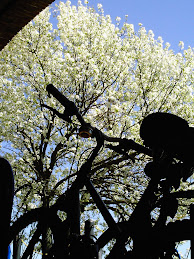

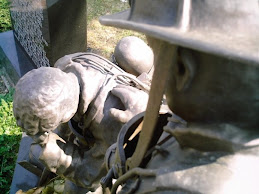

+-+June+2009.jpg)
